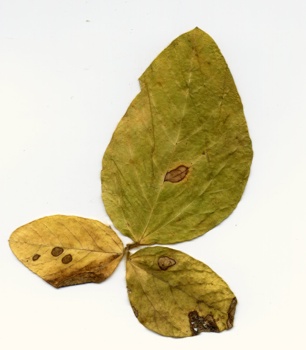Diseases
Cercospora sojina Hara - Frogeye Leaf Spot of Soybean
Systematic position.
Class Deuteromycetes, order Hyphomycetales, family Dematiaceae, genus Cercospora.Synonyms.
Cercospora daizu Miura; ascigerous stage - Mycosphaerella phaseolicola.Biological group.
Saprobiont.Morphology and biology.
Sources of the infection are the infected vegetation residues of cultural and wild-growing soya and seeds of cultural soya. Brown surface spots or deep ulcers with dark-brown limb and plentiful dirty-gray sporification appear on cotyledons. The spots are light gray on leaves and beans, with well defined limb; dark gray bloom of sporification is visible on lower side of spots. The spots are violet-red on stalks, extended, with brown limb and not abundant sporification. There are two kinds of spots on seeds, some are irregular-rounded, convex or plane, with sharp brown limb, the other ones are convex, dark brown, without limb, with indistinct edges. Conidia are colorless, obclavate, 1-14-septate, 45.35-163.56 x 5.07-10.14 mkm in size. Infection of spring sprouts and summer adult plants occurs by wintered and newly forming conidia. The Cercosporosis development incubation period lasts 10-14 days in summer and 17-21 days in spring and autumn.Distribution.
In Russia the disease meets mainly in Primorskii and Khabarovsk Territories, Amur Region, also known in the Northern Caucasus and Volga Regionis; it is distributed in Ukraine and Moldova; disease is also known in China, Japan, India, the Western Europe and USA.Ecology.
The most intensive infection and plentiful sporification occur at temperature 20-30.C and relative humidity 90-100%. The disease develops very poorly at air temperatures 5-10 and 30.C and higher and at relative humidity 80% and lower.Economic significance.
The agent of Frogeye Leaf Spot of Soybean is highly specialized, affecting only cultural and wild soya. The disease can reduce yield of the culture in 3-8 times; sowing and qualitative characteristics of seeds are also reduced; the fat contents of seeds is reduced by 2.1-6.9 %, protein by 4-5%. Control measures are crop rotation, autumn plowing, destruction of wild-growing soya serving as infection; late sowing, duly harvesting and drying of grain; seed dressing, chemical treatments of plants during vegetation, use of resistant varieties.Related references
Ovchinnikova A.M. 1967. Fungal diseases of soya in Primorskii Territory. PhD Thesis. Leningrad. VIZR, 20 p. (in Russian).Pidoplichko N.M. 1977. Fungal parasites of cultural plants. Guide, vol.2. Kiev: Naukova Dumka, 299 p. (in Russian).
Zaostrovnykh V.I., Dubovitskaya L.K. 2003. Harmful organisms of soya and system of phytosanitary optimization of its crops. Novosibirsk: Kemerovo SKHI, Dal.nevostochnyi GAU, 528 p. (in Russian).


